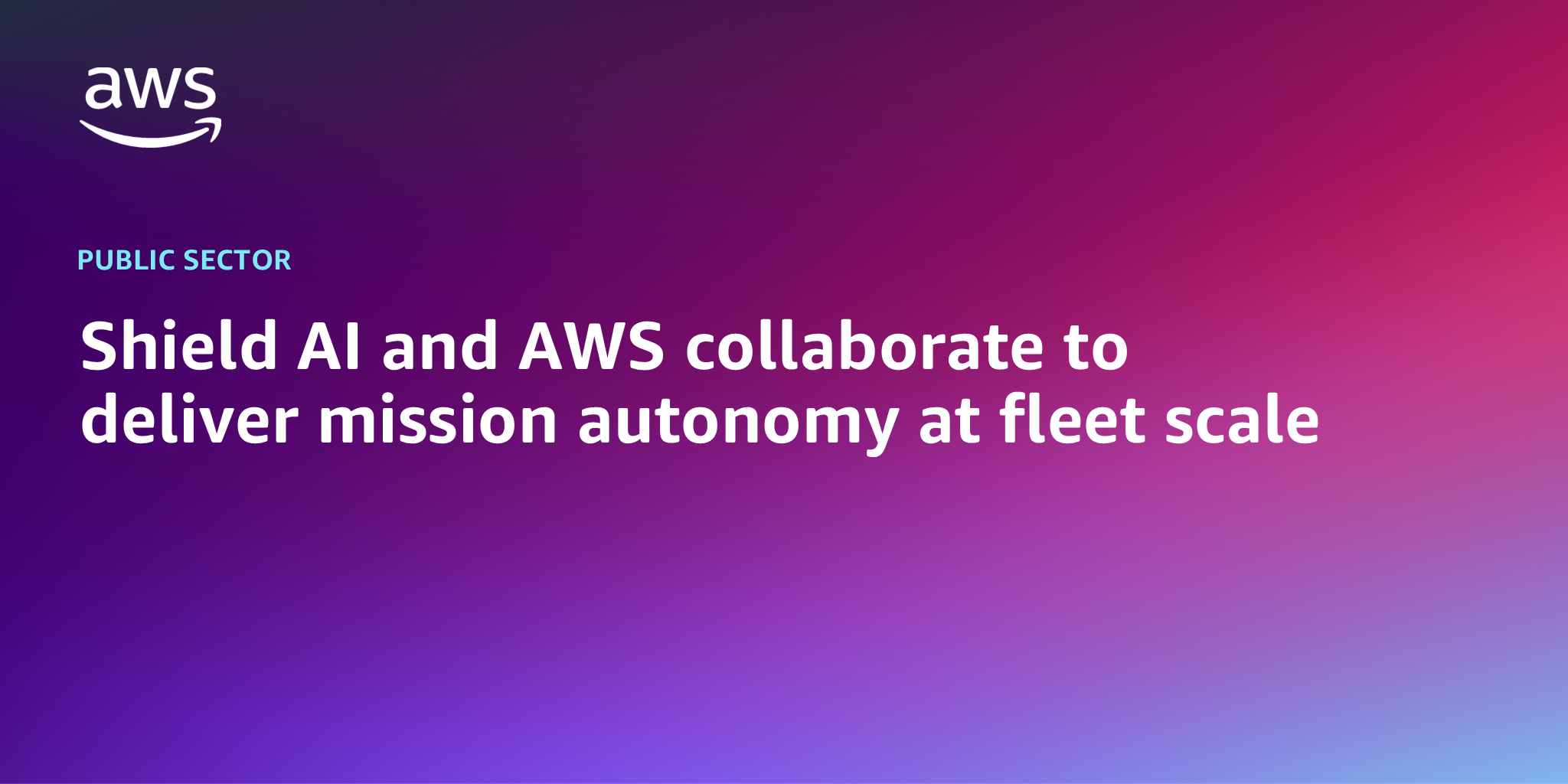AWS Public Sector Blog
Shield AI and AWS collaborate to deliver mission autonomy at fleet scale
The rapid growth of autonomous systems in defense and other sectors is creating new challenges in software deployment and management. Market analysis highlights this trend, with the global military drone and unmanned aerial vehicle (UAV) market projected to expand at an estimated compound annual growth rate of 11.2 percent through 2033.
This significant growth in military UAVs, which serve as a proxy for the broader autonomous systems market, underscores the urgent need for scalable, secure, and efficient software deployment solutions. As the number of autonomous platforms increases, so does the complexity of managing their software systems. In response to this growing challenge, Shield AI and Amazon Web Services (AWS) have collaborated and successfully demonstrated a scalable architecture and proof of concept (PoC) that addresses challenges often seen when deploying autonomy software and machine learning algorithms onto autonomous systems. By integrating Shield AI’s platform agnostic autonomy software development kit, Hivemind Enterprise, with AWS IoT Core and Amazon Elastic Container Registry (ECR), autonomy developers can develop a Hivemind Pilot and—after simulation and tests are complete—deploy it directly to their chosen hardware platform from the AWS Cloud using either the Hivemind command line interface (CLI) or user interface.
For defense customers fielding autonomous systems, software deployment challenges stem from several factors, including:
- The expanding variety of autonomous vehicles across air, land, and sea
- The increasing need for mission-specific collaboration between vehicles
- The need to rapidly deploy updates across large fleets of vehicles in Denied, Disrupted, Intermittent, and Limited (DDIL) environments.
Emerging conflict demands quick software updates and reconfiguration across the various software components of these systems. From embedded vehicle control firmware to mission specific ML models and AI pilots, these updates must deploy securely and reliably across vehicle fleets maintaining system integrity to counter evolving threats and mission needs. While we have seen rapid development across many aspects of autonomous vehicle systems including advanced hardware and sensors, autonomous navigation and perception, and communication, updating these systems often involves manual time-intensive processes that can slow initial development and testing of new capabilities, can cause bottlenecks during missions, and introduces opportunity for misconfiguration.
Liz Martin, AWS managing director, Department of Defense business, emphasizes the importance of this collaboration: “Our defense customers require rapid autonomous software updates to maintain readiness and address emerging mission requirements. Through the collaboration between Shield AI and AWS, we have a solution that provides scalable development and deployment of mission autonomy across fleets of autonomous platforms.”
The collaboration addressed the challenge of updating autonomous systems by building a flexible solution which uses AWS IoT Core as a scalable and secure mechanism to coordinate deployment updates and status between the Shield AI software stack (EdgeOS) running on autonomous hardware platforms and Shield AI autonomy development platform running in the cloud. Because the Hivemind Pilots are deployed as containers, once a new deployment is ready and communicated via AWS IoT Core to the autonomous platform, the container is securely retrieved from Amazon ECR where it is staged by Hivemind as a part of the development and deployment integration, creating a streamlined cloud to autonomous platform deployment pipeline. In summary, the solution enables:
- Centralized control and rapid deployment of Hivemind Pilot software
- Secure, cloud-based distribution to field systems
- Scalable management of large autonomous fleets
- Real-time monitoring and control of deployment processes
“Developing autonomy is both complex and costly—but with AWS, we’re making it faster, easier, and more scalable,” said Nathan Michael, chief technology officer at Shield AI. “This collaboration brings together the Hivemind Enterprise autonomy stack and AWS infrastructure to streamline how customers develop, deliver, and sustain intelligent autonomous systems across large, distributed fleets.”
The collaboration delivers advantages for both defense and commercial customers. Defense customers can now maintain heightened mission readiness by rapidly updating their autonomous fleets to counter emerging threats and adapt to changing mission parameters. This capability is coupled with increased operational flexibility, allowing teams to quickly modify autonomous capabilities for new environments and mission types. The solution also strengthens security measures by ensuring all platforms consistently run the most current, secure software versions, while providing centralized management and monitoring of autonomous platforms.
In the commercial sector, the benefits extend across multiple industries. Agricultural operations can now efficiently update fleets of autonomous tractors to accommodate seasonal changes and implement new farming techniques. The oil and gas industry can deploy crucial updates to offshore autonomous systems, enhancing both safety protocols and operational efficiency. In logistics and warehousing, businesses can seamlessly modify their autonomous vehicle fleets to adapt to evolving inventory requirements and routing needs. Mining operations benefit from the ability to quickly update autonomous equipment to accommodate new terrain conditions or extraction methodologies.
Conclusion
The collaboration between Shield AI and AWS addresses a critical challenge in autonomous systems management. By demonstrating rapid, secure mission autonomy software deployment, we’re enabling organizations across defense and commercial sectors to fully leverage the power of their autonomous fleets. This integration also establishes a foundation for post-mission data capture, which is crucial for driving rapid pilot development and continuous improvement of autonomous capabilities. In the next phase of our collaboration, we are transitioning from proof of concept to production, and we’re excited to explore how this solution will transform operations and unlock new possibilities in autonomy.
For more information on autonomous systems, please email your AWS account team or Shield AI representative.
